How nice it is to live a simpler life in the Nova Scotia countryside. That’s the jist of Mike Aubé’s song, I’d Rather Be.
Annapolis Valley video guru Kim Smith filmed Mike walking through the autumn woods to make the video. Here it is:

Life in Nova Scotia
How nice it is to live a simpler life in the Nova Scotia countryside. That’s the jist of Mike Aubé’s song, I’d Rather Be.
Annapolis Valley video guru Kim Smith filmed Mike walking through the autumn woods to make the video. Here it is:
Two snow days in a row! The kids are happy. We have about 35cm/14″ of fluffy stuff on the ground. We’re glad we stayed on top of it yesterday during the storm, plowing the driveway twice, clearing the entrance after the snowplow went by, and keeping the car near the road and shoveled out, ready to go.
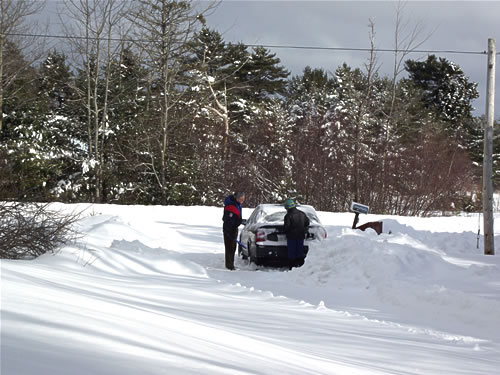
 Blogging has brought an unexpected opportunity. Out of the blue, I was invited, along with a number of other bloggers, to participate in a cross-Canada photography contest using Fujifilm digital cameras. I was sent a Fujifilm FinePix S1800 to play with, and I’ve been happily shooting away, looking especially hard for beauty in a season when we tend to focus our attention indoors, chasing sunrises, carrying a tripod around and exploring the features of this fun camera.
Blogging has brought an unexpected opportunity. Out of the blue, I was invited, along with a number of other bloggers, to participate in a cross-Canada photography contest using Fujifilm digital cameras. I was sent a Fujifilm FinePix S1800 to play with, and I’ve been happily shooting away, looking especially hard for beauty in a season when we tend to focus our attention indoors, chasing sunrises, carrying a tripod around and exploring the features of this fun camera.
The S1800 is a consumer-level camera, currently selling for under $200. It makes me look like a serious photographer as I walk around town, but it isn’t actually a D-SLR. Its range of features are a result of how computer technology has advanced. It certainly provides a lot of bang for the buck.
I can enter 10 photos in the competition. My submissions are included in recent posts, including an instructional article about taking panoramas with the Fujifilm FinePix S1800. Here are a couple of shots taken one evening in Lunenburg. I’ll be adding to some of the photo album galleries soon.
Other entries can be seen on Cams Across Canada’s site on Flickr.
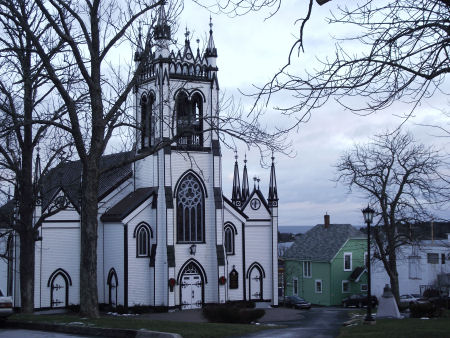

 The Fujifilm FinePix S1800 that I’ve been using (read about the contest I have been invited to enter) has an 18x optical zoom lens that gives the equivalent of a wide-angle 28 mm to a telephoto 504 mm.
The Fujifilm FinePix S1800 that I’ve been using (read about the contest I have been invited to enter) has an 18x optical zoom lens that gives the equivalent of a wide-angle 28 mm to a telephoto 504 mm.
This is a huge range for a zoom lens. It makes for a very versatile camera, especially given the camera’s handy size, which is bulkier than your average point-and-shoot, but nothing like a professional kit with interchangeable lenses and heavy telephotos. At under $200, this is not a professional camera, however; it is clearly pitched at the consumer market as a step up from a typical point-and-shoot. So here’s what you can expect from the lens.


There is no way that my old 35mm SLR could have taken a photo in focus like the one directly above without being mounted on a secure tripod and using the shutter timer so that my hand wouldn’t jostle the camera as I took the picture.
But I took the photo above without a tripod, and achieved this level of focus thanks to the camera’s “dual image stabilization”.
And in between the wide angle and the telephoto are a wide range of possibilities. A zoom is extremely handy for framing photos on the fly. You can zero in on your subject matter and exclude extraneous items, or you can shoot at wide angle, placing your subject in context, if it is close enough to the camera. Your choice, every time. I really enjoy zoom lenses.
Here is a photo made possible by the zoom. I wanted a picture of a boat sitting on the wharf for the winter in the foreground with Mahone Bay’s famous Three Churches behind it. But I wanted the distant churches to appear big enough so that it wasn’t just about the boat. Solution: back away from the boat so that it appeared smaller, and then zoom in and frame the image. The name of the boat was a bonus.

There are things you can do with a DSLR that you can’t do with a camera like this. But at under $200, it gives most of us more possibilities than we will ever use.
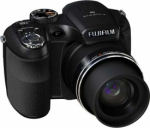
One of the Fujifilm FinePix S1800‘s most impressive features is the ability to knit together two or three shots to make a panorama – right in the camera! The panorama feature is part of what makes this camera – which you can get for under $200 – a lot of fun for the money.
As you’d know if you’ve looked through this website, I love making panoramas. They help to capture the wide open scenery that takes your breath away.
But I’ve been doing it the hard way for years now, photoshopping the pictures together on my computer. Meanwhile, technology has marched on, and a camera can now make a panorama right on the spot!
In this article I want to share my experience with taking panoramas with the Fujifilm FinePix S1800 and give some pointers. It’s so easy to use the panorama mode, but I have learned a few things along the way. I hope that sharing them here will help you take better panoramas with the S1800 or other camera with similar features (including several other Fujifilm models).
I started taking panoramas right away, without reading the manual. The camera taught me.
“How good can it be?” I had to know first. Well, here’s an example:

Please ignore the photographic faux pas of my shadow cast by the rising sun. The point is, I cannot tell where the frames have been stitched together. Amazing!
Once I picked my jaw off the floor, I began to learn more about the ins and outs of the S1800’s panorama feature.
For example, here’s one that didn’t work out quite as well. The sun was playing hide and seek, and the lighting changed between one shot and the next, particularly in the way it reflected off the waves.

The vertical-ish lines in the water show where the frames were joined. (They are not perfectly straight, as is normal with panoramas.)
As I have said, the basic procedure is very easy. Select “PANORAMA” mode with the dial on the top of the camera.
To shoot a panorama with the S1800:

Shoot the first frame – let’s say the one on the right.
The camera is in automatic mode when taking panoramas. It applies the exposure settings from the first picture to the next two, rather than adjusting them for each frame. This is a good thing. Otherwise, as well I know from my experience in Photoshop, the frames may not blend with each other unless you make difficult adjustments to output levels.
The S1800 has a fabulous 18x optical zoom that goes from wide angle, equivalent to a 28 mm SLR lens, to a 500 mm telephoto. How far you are zoomed in or out can affect your panoramas.
I love a 28 mm wide-angle lens for various reasons, but it naturally has some distortion around the edges. When combining two or three wide-angle frames together into a panorama, these distortions can become compounded.
Taking panoramas of ocean scenery with the Fujifilm S1800 taught me that if you are using the lens at its widest angle, keep the horizon in the middle. If you don’t, then as the camera tries to knit the frames together, it produces results that could make you seasick. The distortion of the wide angle lens, which you might not notice in a single shot, becomes exaggerated as the camera tries to combine the frames into a panorama. Check this out:

Keep the horizon in the middle and you’ll do much better with your wide angle panoramas:

Another possible limitation of wide angle panoramas is illustrated here:

The foreground is taking up way too much space and the compounded lens distortion makes it appear to curve away from the viewer on both sides, while the most interesting part of the picture, the sunlit town across the harbour, has been reduced to a small area. Instead of a wide, interesting view, the scene has been reduced to an inside-out fishbowl.
It would be better to zoom in a bit and make the picture about the town itself – as I attempted to do in the second panorama from the top of this article, in which the sun played tricks on me.
There are limits to the correction that the camera can make when you use the wide angle to shoot a subject that is close to you. In the next picture you can see what happened to the filing cabinet which was only six feet away. The camera tried to correct the distortion created by the wide angle, but didn’t entirely succeed.

Zooming in somewhat will often give a better result. Lens distortion is gone and a straight line will show up as a straight line in your photo.
One note of warning, however: the further zoomed in you are, the harder it is to line up the frames.
Below is a detail of a panorama showing what can happen.

The camera’s image stabilization feature, which is a great help when taking single telephoto pictures, will not help you line up your panorama frames with each other. A good tripod, or very steady hands, breath control and patience are what you need in this situation.
I’ve learned a lot while capturing some wonderful panoramic images with the Fujifilm FinePix S1800. Along with the camera’s 28 to 500 mm optical zoom and a number of other features, the panorama setting gives the more advanced amateur photographer new ways to visually explore the world. Thanks to the long zoom and powerful onboard technology, the S1800 is a lot of camera for $200 or less.


The storm predicted by the red sunrise in my last post has passed, leaving the world cleansed and transformed.
And so the shoveling begins. We have about 3-4 inches of very dense snow here near Western Shore on the shore of Mahone Bay. A friend near New Germany, inland, reports at least a foot and a half of “thick heavy snow”. Meanwhile, someone in Kingsburg, which juts out into the Atlantic Ocean, has no snow at all! This pattern is typical: rain near the coast, snow inland.
Here’s how a tidal inlet on Mahone Bay looked this morning:


Another storm is on its way. This one is the kind of blizzard you’d expect in January, with 10 to 15 cm (4 to 6 inches) of snow.
Atlantic Canada has been in the news lately with a series of storms in December, one week after another. If you just watched the weather channel you might think that we’re living in a disaster area and maybe that’s why I haven’t been posting frequently.
But where we live, we haven’t lost power for more than a minute, and we’ve escaped the brunt of the storms. The worst damage tends to be localized, and even though Nova Scotia is small, one side of the province often has very different weather than the other. Some weather systems track up the Bay of Fundy, for example, while others are phenomena of the Atlantic Ocean. And the Margaree Valley has received a lot of rain which seems to get trapped by the surrounding mountains.
The Annapolis Valley was hard hit by one storm which downed many trees, knocking out so many power lines that it took days to restore full service. Berwick United Church Camp, with its 500-year-old towering hemlocks, was badly hit, as was the Kentville Ravine which also has a stand of old growth hemlock. I’ve seen photos of damage in both places on Facebook. It is evident that some of the trees that came down were hollow and perhaps were near the end of their natural life. Thus the storm did what storms do: fell trees so that they can return to the soil and nurture new growth that will flourish in the sunlit openings they leave in their wake. Much as it feels tragic to those who love those trees – and I speak as one who grew up attending Berwick Camp every summer and loved its cool, shaded grounds and majestic trees – this is Nature’s way of renewing itself.
So we’ll take what comes – what else can we do? – and hope the power stays on.

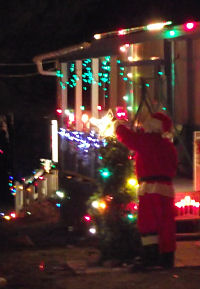
You can’t miss it as you drive along Highway 3 through Martins River. It’s Santaville, a fantasy landscape of lights around and behind the home of Eddie Aulenbach. During the Christmas season, he spends his evenings in his Santa suit, happy to give tours through the grounds: the little cottages and chapel and Santa’s Workshop, all filled with vintage toys and decorations.
My son and I had a tour of Santaville a few years ago, and he was enchanted, though a little scared to say very much to Santa so close to Christmas. Home grown entertainment to be sure, without the production values of a big mall display. But the magic of coloured lights on a dark, dark night, a personal tour from St. Nick himself, and a little stuffed toy (previously loved) at the end of the visit, are enough to please a small child. I enjoyed seeing decorations and toys dating from my own childhood. And it’s free.
It hasn’t been smooth sailing for Santa. In 2002, Aulenbach was charged with unsightly premises by the Municipality. (I’ll concur that the charm of the place is more powerful at night than during the daytime.) The charges didn’t stick, and the Municipality got a lump of coal in its Christmas stocking. Then in 2004, the century-old house burned down in an uninsured fire. The local community held fundraisers, and a generous person donated a mobile home, and so Santaville was saved again – earning some very good children extra special presents the following Christmas.
Do you have childhood memories of Santaville, or have you taken your children through it? If so, please leave a comment below.
(Photos taken with a Fujifilm FinePix F1800.)
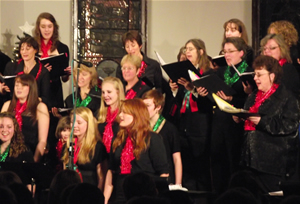
Don’t ever imagine that life in the more rural parts of Nova Scotia is devoid of fine cultural experiences. In fact, there is more going on in many communities than a busy person can take in, and often it is all the richer for being home-grown.
Such was the case tonight when the St. John’s Lutheran Mother & Daughter Choir, directed by Leslee Barry, presented their Christmas Concert. The beautiful, large church was packed. No wonder: the music was very fine, with interesting, complex arrangements well executed, and very accomplished instrumentalists accompanying the choir. Much money was raised for the local food bank, and everyone went home satisfied, and in fine Christmas spirit.
Photos taken with a Fujifilm FinePix S1800 digital camera.
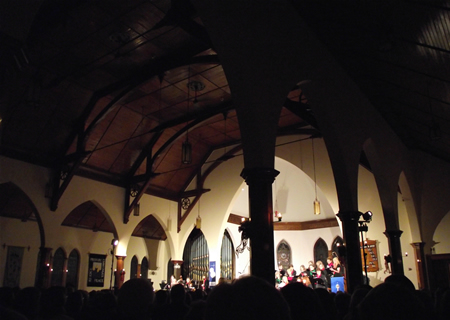
So much the better for knowing several people in the choir! That’s the human scale of life here in Nova Scotia.


Looking for a New Year’s gift? (That excuse will buy you an extra week.)
I’ve put together a calendar of photos from the South Shore of Nova Scotia. You’ll find it in my CaféPress Shop. Price is $19.99 USD.
Yes, it’s printed in the US on demand by CaféPress and ships from the US.
Your results may vary, but I haven’t had to pay duty on printed material (on paper) coming across the border from the US to Canada by mail, whether from Amazon or CaféPress. Clothing is another thing though, and mugs; I’ve had to pay duty as well as GST on those.
I’d love to hear of any CaféPress equivalents based in Canada.